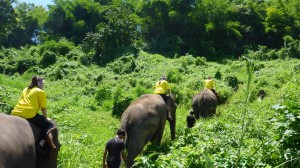Joe Louis rides an elephant
A year before I even thought of backpacking, a friend of mine convinced me to create a bucket list. “Put down all of the things you want to accomplish, have always been interested in doing, or that just sound really exciting. Just brainstorm to get started and don’t think about any constraints or needs. This is an exercise in hope and motivation.”
I took a pen and a piece of notebook paper and started scribbling down activities, destinations, and desired skills. After completing thirty lines, I took a break. Looking down at the paper in front of me, there was a slapdash written collection of wistful wishes, but no order or organization to the items. Number one on the list read: Ride an elephant. That seemed unlikely. I mean how would I be able to do that without going halfway around the world?
I’m not even sure why riding atop an elephant was the first thing to come to mind in considering dream activities. I never thought or talked about it much. I didn’t have a separate vacation fund set aside for elephant riding. And what’s the special appeal of riding an elephant? I’ve gone horseback riding before and enjoyed it; that should have satisfied any curiosity for the animal transportation category, right?

But elephant riding IS different. And it is special. And it belongs up there on the list. The lion may be the king of the jungle. The whale is the behemoth of the ocean. But when it comes to sheer, majestic size, the elephant rules the land. As a child I wasn’t taught “e is for elk” or “e is for ermine”. No, “e is for elephant” and that’s that. When ancient kings were transported long distances, they did not ride atop donkeys or mules. Elephants carried them on their backs, higher than all others.
Chiang Mai, Thailand
To Ride or Not to Ride
You’ve probably seen pictures of friends riding on elephants posted up to Facebook or Instagram. Big smile, big trunk, big fomo. Everyone looks happy. It’s like a petting zoo, for adults, on top of elephants! But more often than not there is an untold story behind the pictures. While the humans are having a great time, the elephants’ smiles are forced.
Most tourist elephant parks in Southeast Asia are believed to abuse and mistreat their animals. While there haven’t been full investigations into every camp, it is often easy to see the cruelty as a visitor. The elephants, shackled in captivity, wearily show their exhaustion as they meander the often too-small grounds. Wounds on their legs are evidence of regular beatings. Just the fact that they are domesticated and “broken in” to cater to tourists is likely a sign of harsh training methods.
Before beginning the actual elephant riding activities at the camp I visited, the lead trainer sat the group down for a brief lesson on elephant treatment. He assured us that all animals in the camp were properly cared for and well fed. He explained that elephants were very expensive and therefore it did not make sense to abuse them. The sale and purchase of an elephant are carefully monitored as well as the death of one of the animals. The ten minute explanation did little assuage my concerns. For some reason, it seemed more like a defense than expository background and the whole scene lacked sincerity. As a tourist, I was there and complicit in the activity, but this quick pep talk was not going to clear my conscience.
There are a few positively regarded sanctuaries, such as the Elephant Nature Park in Thailand, which are known to properly care for their animals. The prices are higher, but are negligible when considering the moral implications. You may have your heart set on an elephant ride, but you should consider the animals themselves when you make your decision.

Choose a program
Elephant riding may involve several different activities including elephant shows (tricks), elephant training, elephant washing, and actually riding atop the elephants. They can range from half a day to a a couple of days. Do you just want a picture on an elephant or do you want to sleep, feed, and bathe with the long-nosed mammals? Costs vary for programs, but the longer the program, the more expensive. They typically range from $50 to $200.
Keep in mind that many of the elephant riding companies, especially the cheaper ones and especially the ones with unnatural activities (an elephant painting a picture), mistreat the animals. It’s hard to know which ones are actually humane and which ones just claim to be. Read reviews and make a decision that you are comfortable with.
Rolling in the mud
The camp may give you a jumpsuit (ratty overalls) to wear over your clothes, but don’t wear anything nice, especially if you plan to bathe the elephants.
Don’t sweat the small stuff
If you do an elephant training program the mahout will teach you commands for forward, backward, turn, etc. Don’t worry about mastering them because the elephants are often so trained that they don’t listen to you and follow a specific path regardless, stopping as they please to eat nearby flora. Unfortunately, they are kept in line by the accompanying mahouts that continually prod the burdened beasts or throw food in front if them. Literally a case of stick and carrots.
Have fun!
If you partake in the activity, then enjoy yourself. You’re on an elephant! Pretend you are Hannibal entering war (although the elephants are so big and slow it is hard to imagine they are leading a strong attack). Pretend you are with Dumbo leaving on adventure! Enjoy.
